BDS Satellite Clock Prediction Considering Periodic Variations
Abstract
:1. Introduction
2. Materials and Methods
2.1. Preprocessing of Clock Offsets
2.2. Analysis of Periodic Variations in BDS Satellite Clock Offsets
2.3. BDS Satellite Clock Prediction Model Considering Periodic Variations
3. Results
3.1. Accuracy Analysis of Clock Offset Fitting
3.2. BDS Satellite Clock Prediction Analysis
4. Discussion
5. Conclusions
- Both the amplitude and frequency of periodic terms in clock offsets vary with time for all BDS satellites discussed in this paper.
- For satellites with marked periodic variations, the fitting accuracy of TFAM is significantly improved. Compared with SAM, the mean RMS of the TFAM fitting residuals increases by 10.5% for WHU clock offsets and 12.2% for GFZ clock offsets.
- TFAM can improve the average prediction accuracy of the SAM. Compared with SAM, the improvement rate of the prediction accuracy using TFAM of the 6 h, 12 h, 18 h and 24 h is in the range of 6.4% to 10% for WHU clock offsets, while 11.1% to 14.4% for GFZ clock offsets.
- Compared with SAM, for C06, C14, and C32 with marked periodic variations, the prediction accuracy using TFAM is improved by 26.7%, 16.2%, and 16.3% for WHU clock offsets, and 29.8%, 16.0%, 21.0%, and 9.0% of C06, C14, C28, and C32 for GFZ clock offsets.
Author Contributions
Funding
Institutional Review Board Statement
Informed Consent Statement
Data Availability Statement
Acknowledgments
Conflicts of Interest
References
- Zhou, P.; Yang, H.; Xiao, G.; Du, L.; Gao, Y. Estimation of GPS LNAV based on IGS products for real-time PPP. GPS Solut. 2019, 23, 27. [Google Scholar] [CrossRef]
- Hadas, T.; Bosy, J. IGS RTS precise orbits and clocks verification and quality degradation over time. GPS Solut. 2015, 19, 93–105. [Google Scholar] [CrossRef] [Green Version]
- Yan, X.; Li, W.; Yang, Y.; Li, W.; Yang, Y.; Pan, X. BDS satellite clock prediction based on a semiparametric adjustment model considering model errors. Satell. Navig. 2020, 1, 11. [Google Scholar] [CrossRef]
- Han, T. Fractal behavior of BDS-2 satellite clock offsets and its application to real-time clock offsets prediction. GPS Solut. 2020, 24, 35. [Google Scholar] [CrossRef]
- El-Mowafy, A.; Deo, M.; Kubo, N. Maintaining real-time precise point positioning during outages of orbit and clock corrections. GPS Solut. 2017, 21, 937–947. [Google Scholar] [CrossRef]
- Xue, H.; Xu, T.; Ai, Q.; Wang, S. The Long-Term Performance Analysis and Comparison of BDS on-Board Atomic Clock Based on Precise Clock Products of IGS Analysis Centers. In China Satellite Navigation Conference (CSNC) 2018 Proceedings; CSNC 2018, Harbin, China, May 2018; Sun, J., Yang, C., Guo, S., Eds.; Springer: Singapore, 2018. [Google Scholar]
- Wang, W.; Wang, Y.; Yu, C.; Xu, F.; Dou, X. Spaceborne Atomic Clock Performance Review of BDS-3 MEO Satellites. Measurement 2021, 175, 109075. [Google Scholar] [CrossRef]
- Lv, Y.; Dai, Z.; Zhao, Q.; Yang, S.; Zhou, J.; Liu, J. Improved Short-Term Clock Prediction Method for Real-Time Positioning. Sensors 2017, 17, 1308. [Google Scholar] [CrossRef] [Green Version]
- Hu, C.; Wang, Q.; Min, Y.; Mao, Y.; Gong, Y. An improved model for BDS satellite ultra-rapid clock offset prediction based on BDS-2 and BDS-3 combined estimation. Acta. Geod. Geophys. 2019, 54, 513–543. [Google Scholar] [CrossRef]
- Janicka, J.; Tomaszewski, D.; Rapinski, J.; Jagoda, M.; Rutkowska, M. The Prediction of Geocentric Corrections during Communication Link Outages in PPP. Sensors 2020, 20, 602. [Google Scholar] [CrossRef] [Green Version]
- Nie, Z.; Gao, Y.; Wang, Z.; Ji, S.; Yang, H. An approach to GPS clock prediction for real-time PPP during outages of RTS stream. GPS Solut. 2018, 22, 14. [Google Scholar] [CrossRef]
- Huang, G.; Zhang, Q.; Xu, G. Real-time clock offset prediction with an improved model. GPS Solut. 2014, 18, 95–104. [Google Scholar] [CrossRef]
- Zheng, Z.; Chen, Y.; Lu, X. An Improved Grey Model and Its Application Research on the Prediction of Real-time GPS Satellite Clock Errors. Chin. Astron. Astrophys. 2009, 33, 72–89. [Google Scholar]
- Xu, J.; Zeng, A. Application of ARIMA (0, 2, q) model to prediction of satellite clock error. J. Geod. Geodyn. 2009, 29, 116–120. [Google Scholar]
- Xu, T.H.; Nie, W.F.; Yang, Y.G.; Ai, Q.S. An enhanced prediction model for BDS ultra-rapid clock offset that combines singular spectrum analysis, robust estimation and gray model. Meas. Sci. Technol. 2021, 32, 105002. [Google Scholar] [CrossRef]
- Huang, G.; Cui, B.; Zhang, Q.; Li, P.; Xie, W. Switching and performance variations of on-orbit BDS satellite clocks. Adv. Space Res. 2018, 63, 1681–1696. [Google Scholar] [CrossRef]
- Lv, Y.; Geng, T.; Zhao, Q.; Liu, J. Characteristics of BeiDou-3 Experimental Satellite Clocks. Remote. Sens. 2018, 10, 1847. [Google Scholar] [CrossRef] [Green Version]
- Yang, H.; Xu, C.; Gao, Y. Analysis of GPS satellite clock prediction performance with different update intervals and application to real-time PPP. Surv. Rev. 2017, 51, 43–52. [Google Scholar] [CrossRef]
- Hauschild, H.; Montenbruck, O.; Steigenberger, P. Short-term analysis of GNSS clocks. GPS Solut. 2013, 17, 295–307. [Google Scholar] [CrossRef]
- Zhou, P.; Du, L.; Lu, Y.; Fang, S.; Zhang, Z.; Yang, L. Periodic variations of BeiDou Satellite Clock Offsets Derived from Multi-satellite Orbit Determination. J. Geod. Geoinf. Sci. 2015, 44, 1299–1306. [Google Scholar]
- Guo, J.; Xu, X.; Zhao, Q.; Liu, J. Precise orbit determination for quad-constellation satellites at Wuhan University: Strategy, result validation, and comparison. J. Geod. 2016, 90, 143–159. [Google Scholar] [CrossRef]
- Bhattarai, S. Satellite Clock Time Offset Prediction in Global Navigation Satellite Systems. Ph.D. Thesis, University College London, London, UK, 2015. [Google Scholar]
- Youn, J.H.; Jeongho, C.; Moon, B.H. Improving prediction accuracy of GPS satellite clocks with periodic variation behavior. Meas. Sci. Technol. 2010, 21, 073001. [Google Scholar]
- Montenbruck, O.; Hugentobler, U.; Dach, R.; Steigenberger, P.; Hauschild, A. Apparent clock variations of the Block IIF-1 (SVN62) GPS satellite. GPS Solut. 2012, 16, 303–313. [Google Scholar] [CrossRef]
- Xu, B.; Wang, L.; Fu, W.; Chen, R.; Li, T.; Zhang, X. A Practical Adaptive Clock Offset Prediction Model for the Beidou-2 System. Remote. Sens. 2019, 11, 1850. [Google Scholar] [CrossRef] [Green Version]
- Huang, G.; Cui, B.; Zhang, Q.; Fu, W.; Li, P. An Improved Predicted Model for BDS Ultra-Rapid Satellite Clock Offsets. Remote Sens. 2018, 10, 60. [Google Scholar] [CrossRef] [Green Version]
- He, L.; Zho, H.; Liu, Z.; Wen, Y. Improving Clock Prediction Algorithm for BDS-2/3 Satellites Based on LS-SVM Method. Remote Sens. 2019, 11, 2554. [Google Scholar] [CrossRef] [Green Version]
- Chen, Q.; Dam, T.V.; Sneeuw, N.; Collilieux, X.; Weigelt, M.; Rebischung, P. Singular spectrum analysis for modeling seasonal signals from GPS time series. J. Geodyn. 2013, 72, 25–35. [Google Scholar] [CrossRef]
- Senior, K.L.; Ray, J.R.; Beard, R.L. Characterization of periodic variations in the GPS satellite clocks. GPS Solut. 2008, 12, 211–225. [Google Scholar] [CrossRef]
- Formichella, V.; Galleani, L.; Signorile, G.; Sesia, L. Time–frequency analysis of the Galileo satellite clocks: Looking for the J2 relativistic effect and other periodic variations. GPS Solut. 2021, 25, 56. [Google Scholar] [CrossRef]
- Wang, B.; Lou, Y.; Liu, J.; Zhao, Q.; Su, X. Analysis of BDS satellite clocks in orbit. GPS Solut. 2016, 20, 783–794. [Google Scholar] [CrossRef]
- Wang, G.; Liu, L.; Xu, A.; Pan, F.; Cai, Z.; Xiao, S.; Tu, Y.; Li, Z. On the capabilities of the inaction method for extracting the periodic components from GPS clock data. GPS Solut. 2018, 22, 92. [Google Scholar] [CrossRef] [Green Version]
- Wang, D.; Guo, R.; Xiao, S.; Xin, J.; Tang, T.; Yuan, Y. Atomic clock performance and combined clock error prediction for the new generation of BeiDou navigation satellites. Adv. Space Res. 2018, 63, 2889–2898. [Google Scholar] [CrossRef]
- Tian, J.; Huang, G.; Wang, L.; Zhang, Q.; Liu, W. A Data Quality Control Method for the Beidou-2 Satellite Clock bias. J. Geod. Geodyn. 2017, 37, 215–220. [Google Scholar]
- Wang, C. Solar radiation pressure modelling for BeiDou navigation satellites. Ph.D. Thesis, Wuhan University, Wuhan, China, 2019. [Google Scholar]
- Tan, B.; Yuan, Y.; Zhang, B.; Hsu, H.; Ou, J. A new analytical solar radiation pressure model for current BeiDou satellites: IGGBSPM. Sci. Rep. 2016, 6, 32967. [Google Scholar] [CrossRef]
- Wang, C.; Guo, J.; Zhao, Q.; Liu, J. Empirically derived model of solar radiation pressure for BeiDou GEO satellites. J. Geod. 2018, 93, 791–807. [Google Scholar] [CrossRef]
- Pavlis, N.; Holmes, S.; Kenyon, S.; Factor, J. The development and evaluation of the earth gravitational model 2008 (EGM2008). J. Geophys. Res. Solid Earth 2013, 118, 2633. [Google Scholar] [CrossRef]
- Lyard, F.; Lefevre, F.; Letellier, T.; Letellier, T.; Francis, O. Modelling the global ocean tides: Modern insights from ES2004. J. Geophys. Res. Atmos. 2004, 56, 394–415. [Google Scholar] [CrossRef]
- Petit, G.; Luzum, B. IERS Conventions 2010; Technical Report; IERS Convention Center: Frankfurt, Germany, 2010. [Google Scholar]
- Beutler, G.; Brockmann, E.; Gurtner, W.; Hugentobler, U.; Mervart, L.; Rothacher, M. Extended orbit modelling techniques at the CODE processing center of the international GPS service for geodynamics (IGS): Theory and initial results. Eur. Respir. J. 1994, 19, 367–386. [Google Scholar]
- Steigenberger, P.; Thoelert, S.; Montenbruck, O. GNSS satellite transmit power and its impact on orbit determination. J. Geod. 2018, 92, 609–624. [Google Scholar] [CrossRef]
- Rodriguez-Solano, C.J. Impact of the albedo modeling on GPS orbits. Ph.D. Thesis, Technische Universität München (TUM), München, Germany, 2009. [Google Scholar]
- Peng, H.; Yang, Y.; Wang, G. Performance Analysis of BDS Satellite Orbits during Eclipse Periods: Results of Satellite Laser Ranging Validation. Acta Geod. Cartogr. Sin. 2016, 45, 639–645. [Google Scholar]
- Xia, F.; Ye, S.; Chen, D.; Jiang, N. Observation of BDS-2 IGSO/MEOs yaw-attitude behavior during eclipse seasons. GPS Solut. 2019, 23, 71. [Google Scholar] [CrossRef]
- Duan, B.; Hugentobler, U. Enhanced solar radiation pressure model for GPS satellites considering various physical effects. GPS Solut. 2021, 25, 42. [Google Scholar] [CrossRef]
- Lou, Y.; Zhang, W.; Wang, C.; Yao, X.; Shi, C.; Liu, J. The impact of orbital errors on the estimation of satellite clock errors and PPP. Adv. Space Res. 2014, 54, 1571–1580. [Google Scholar] [CrossRef]
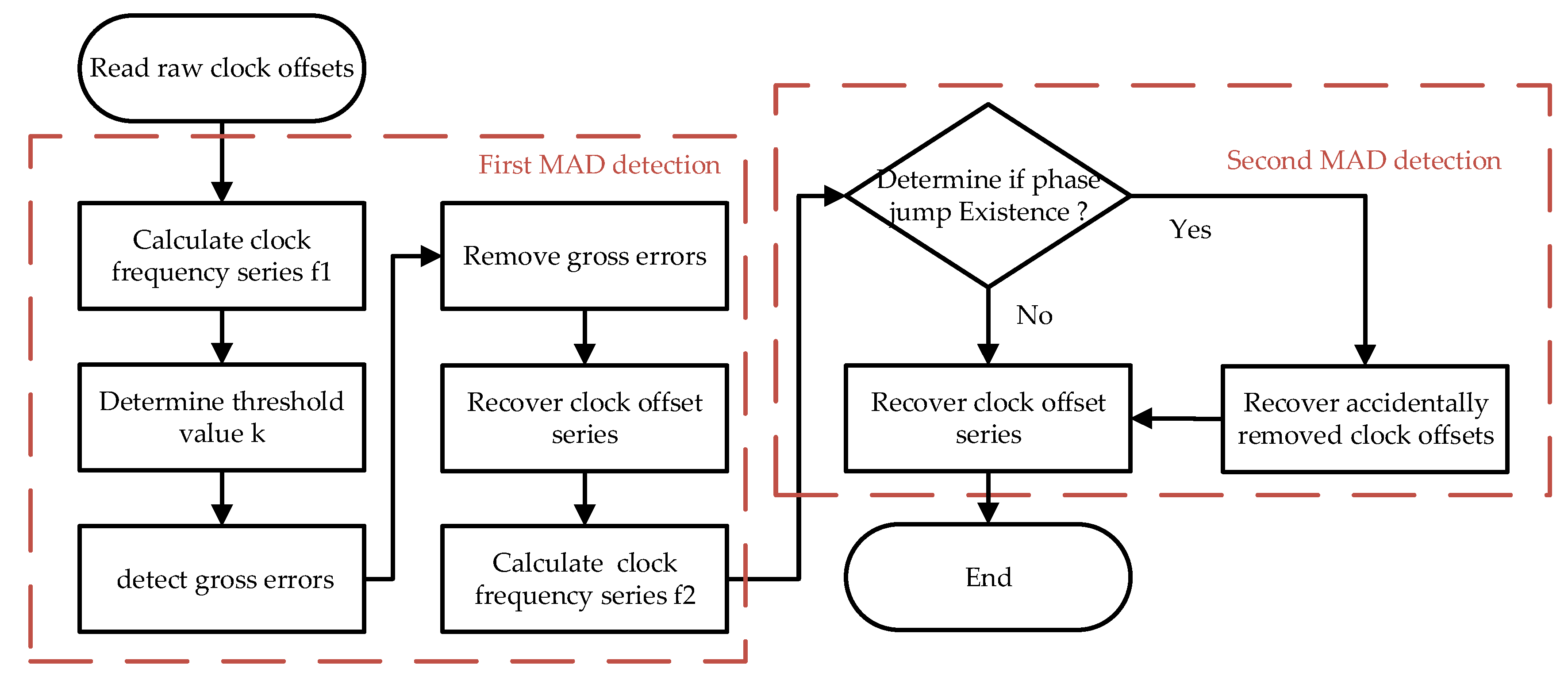
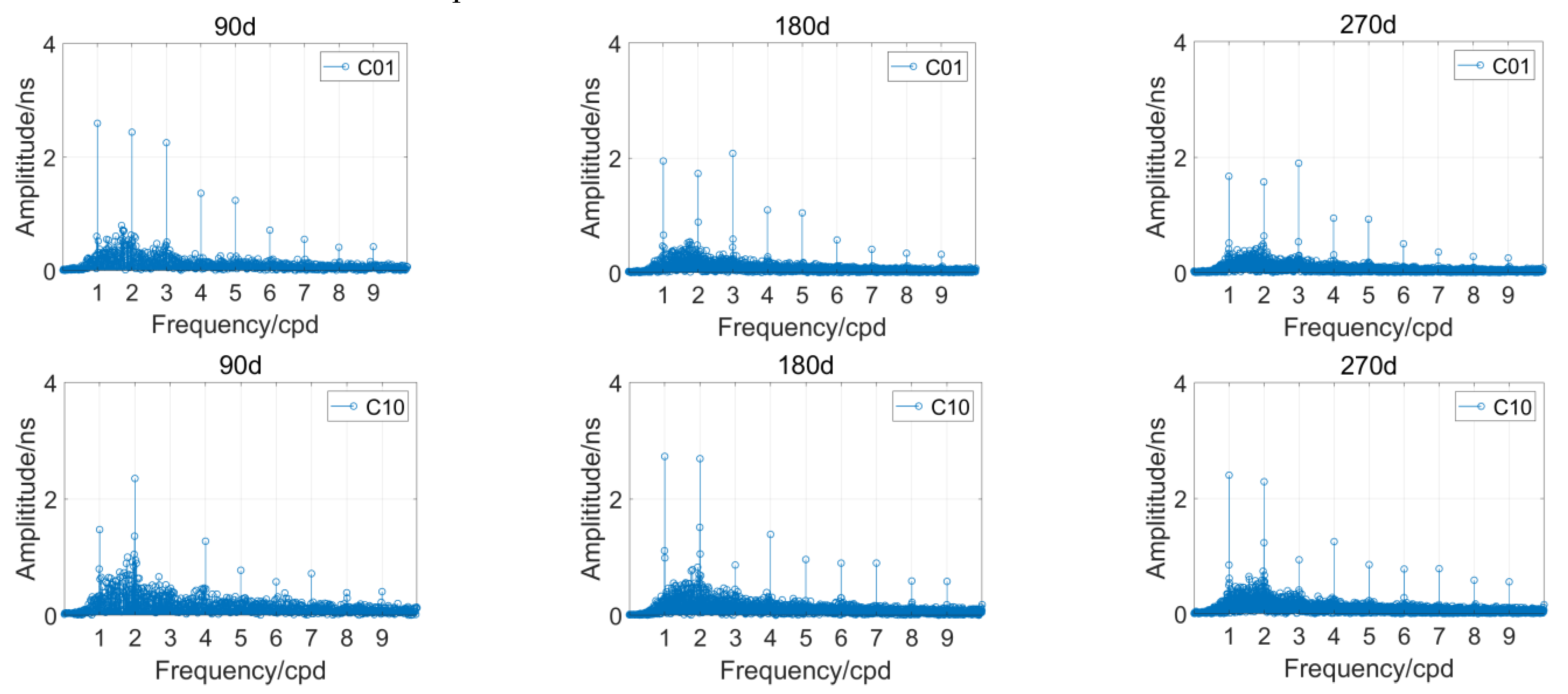

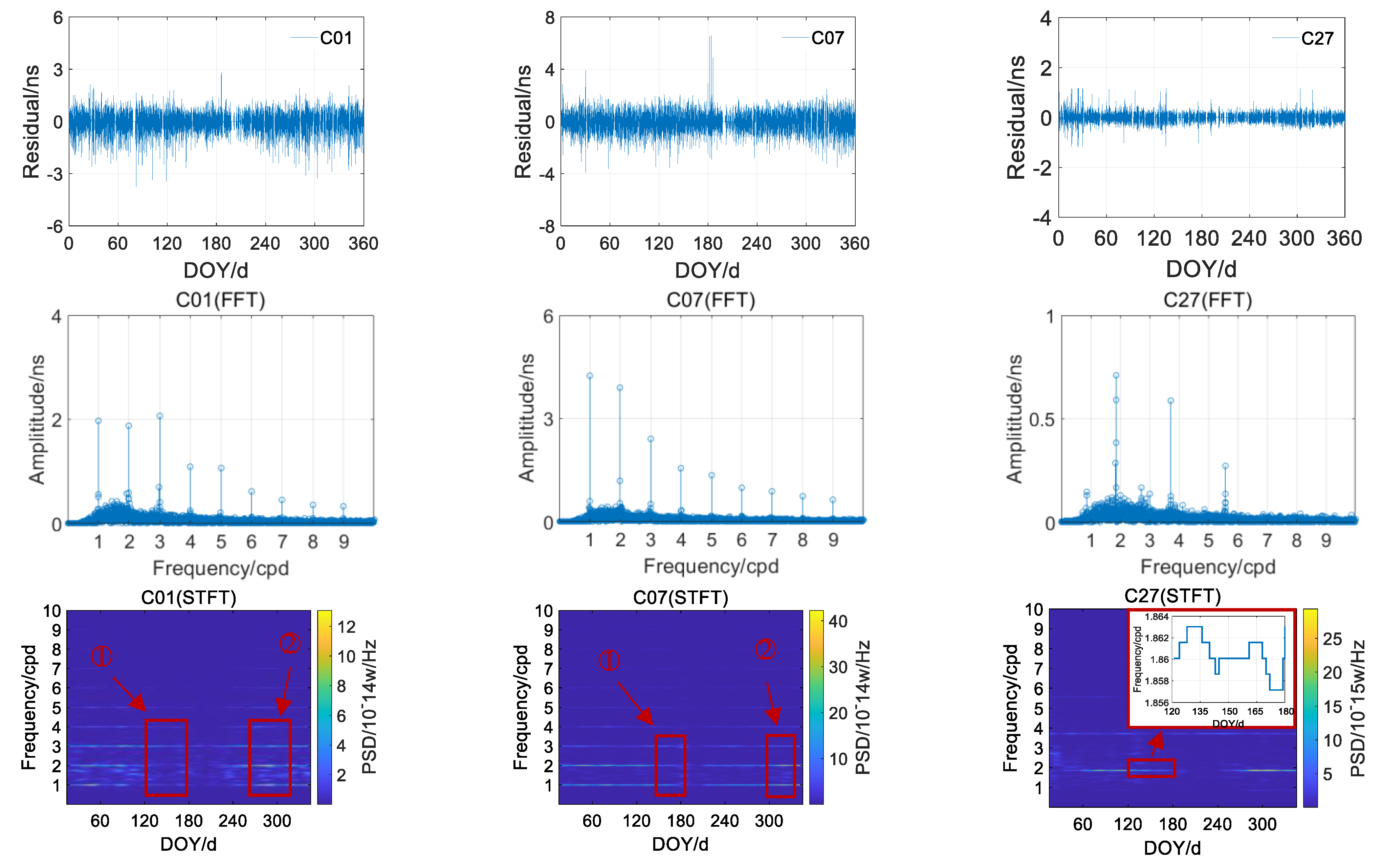
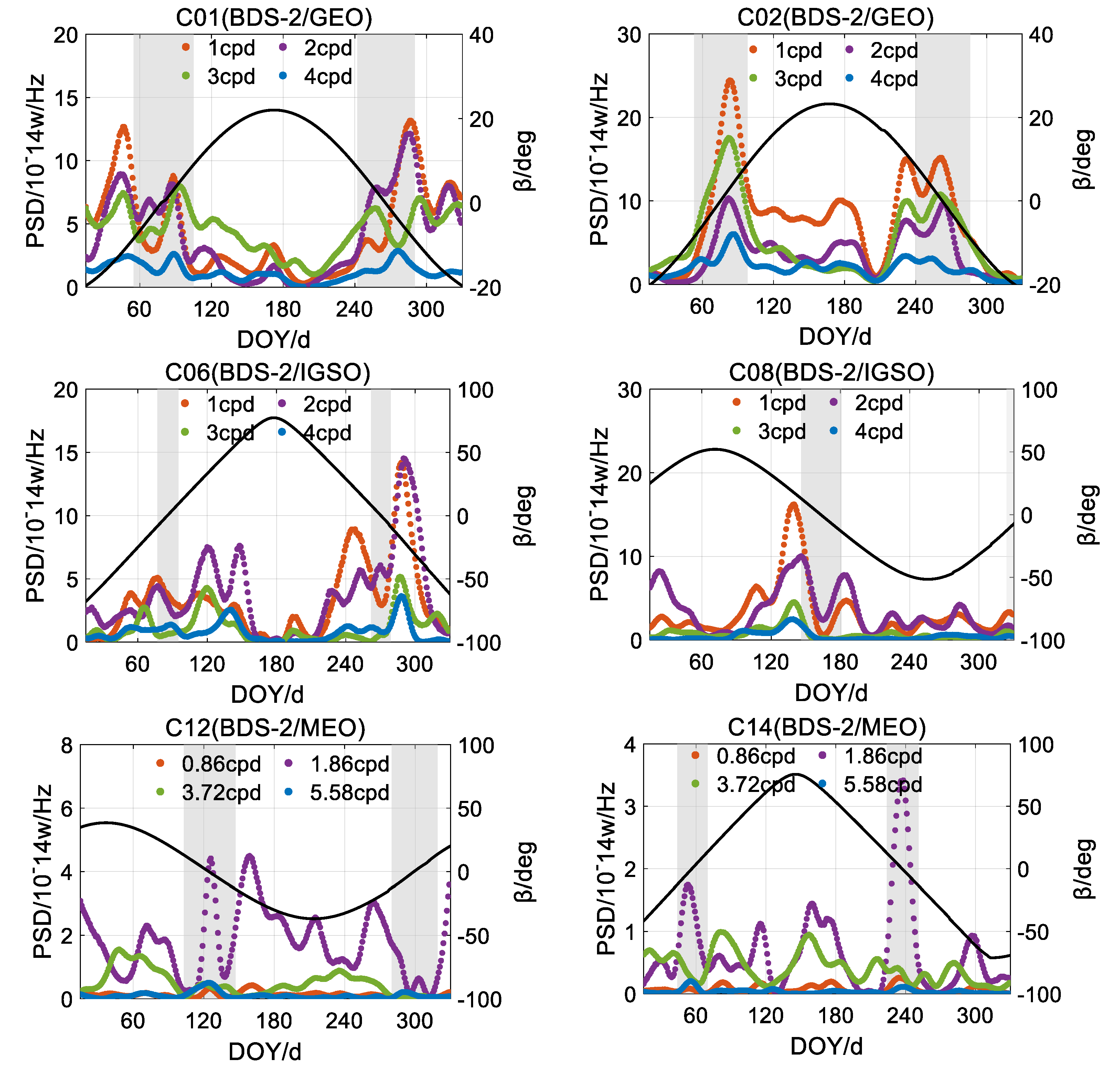
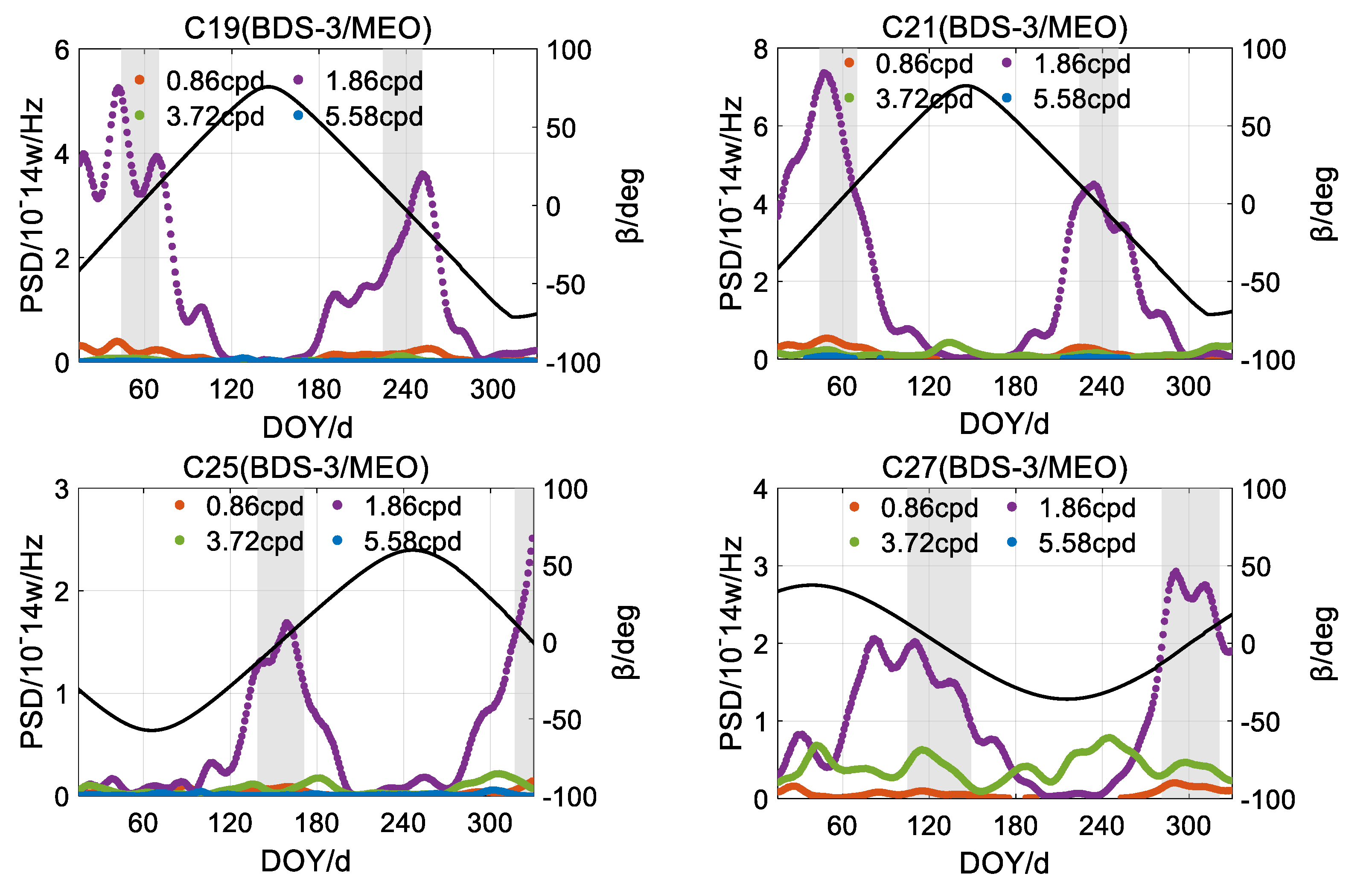
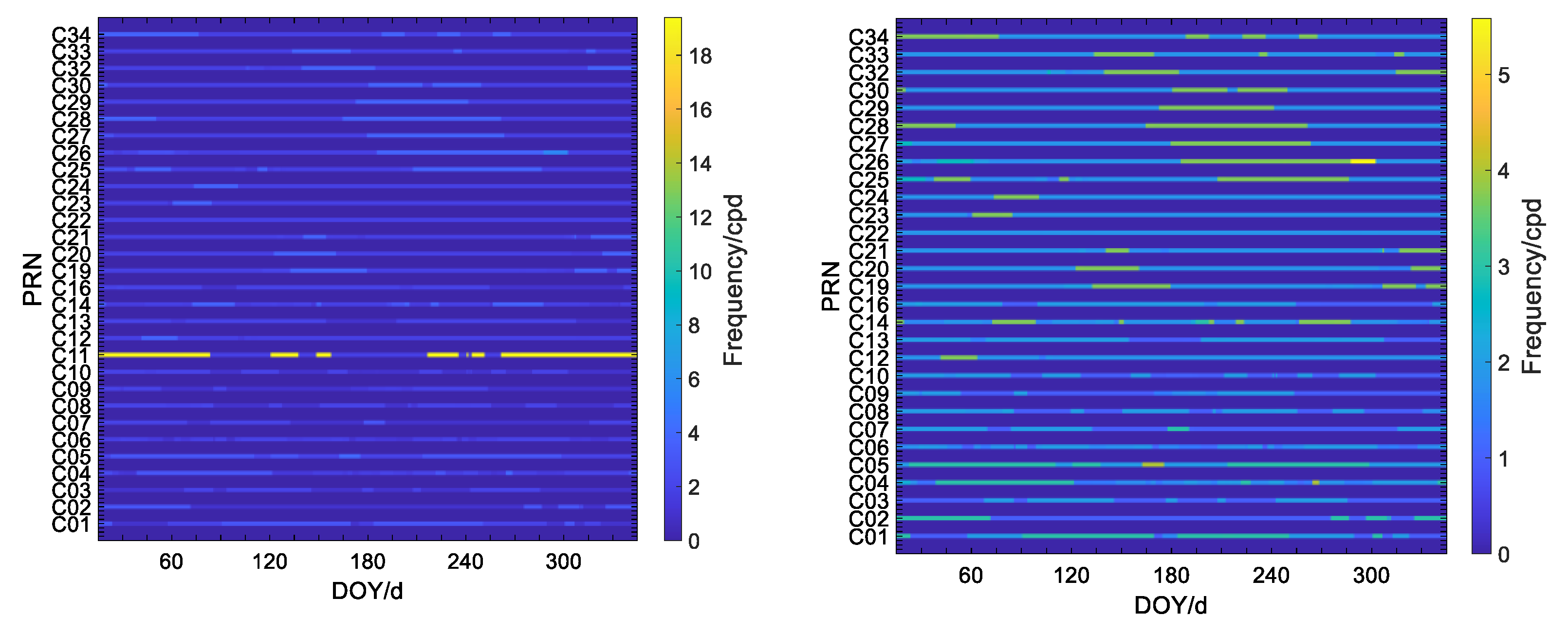
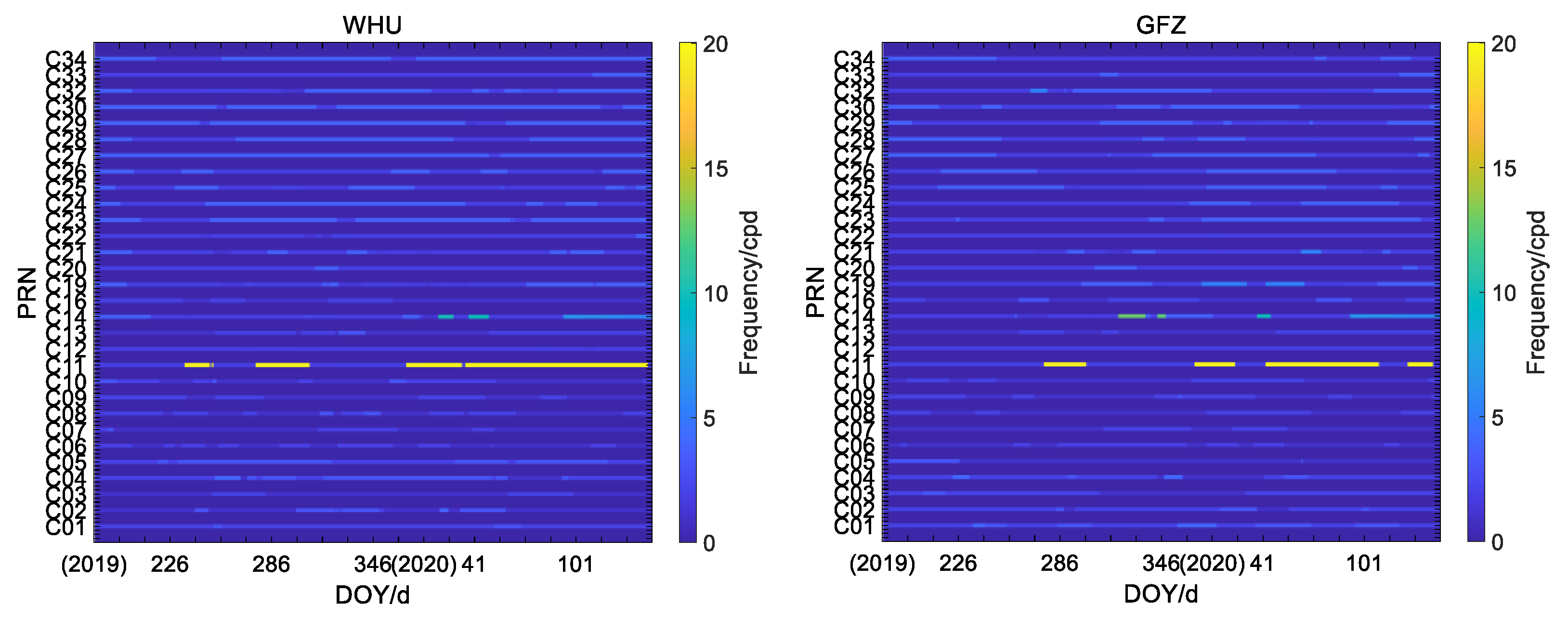
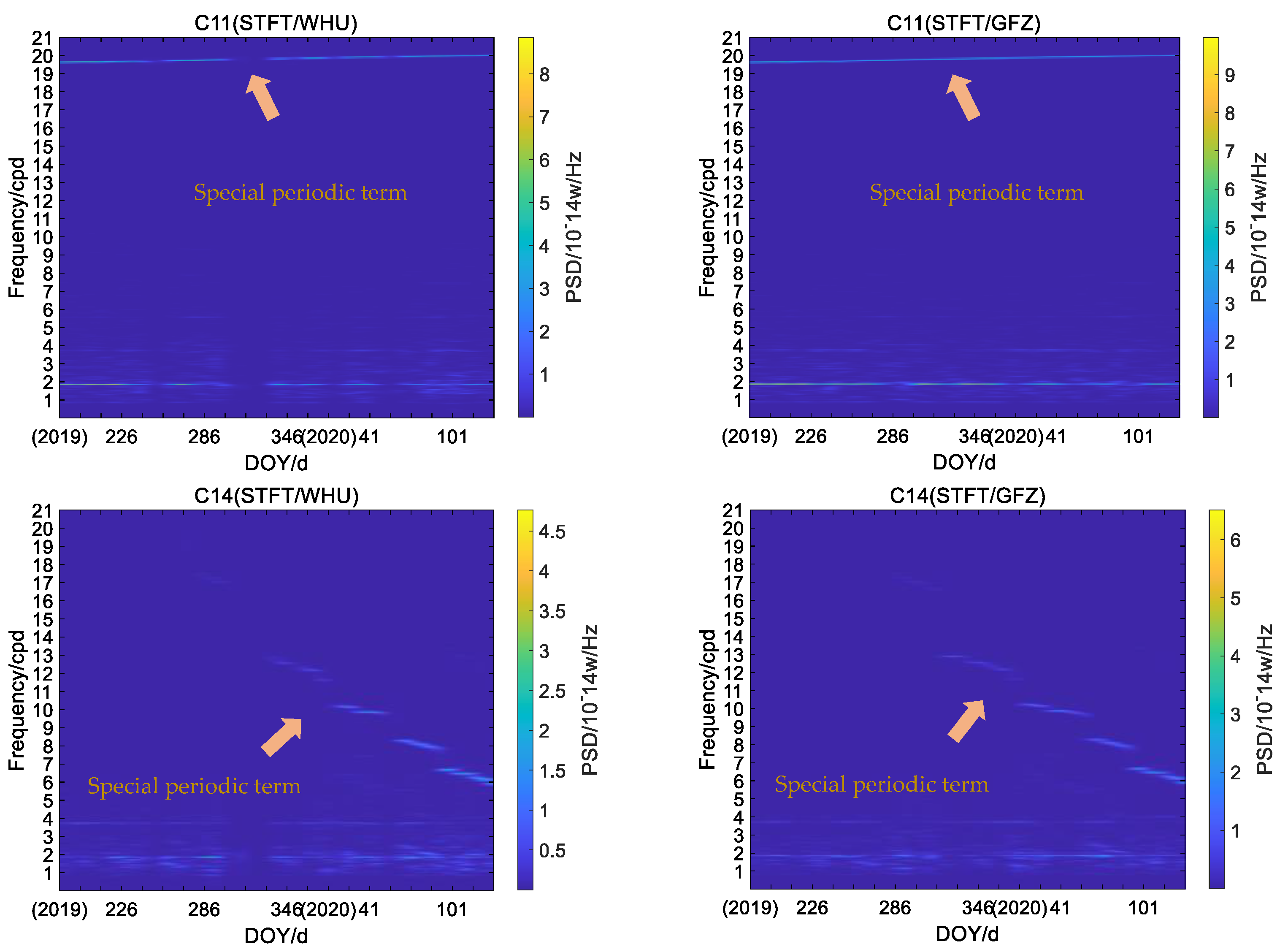
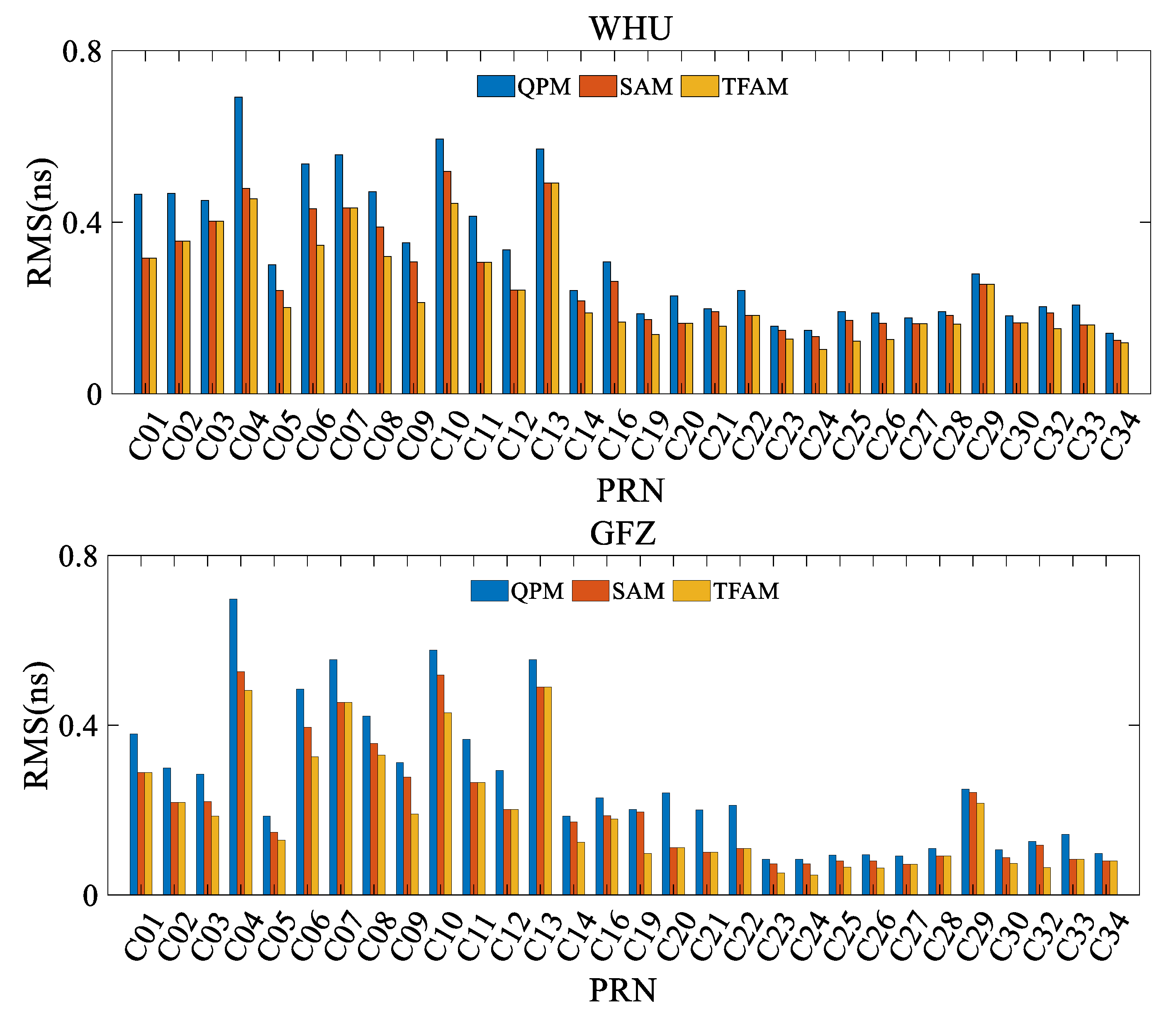
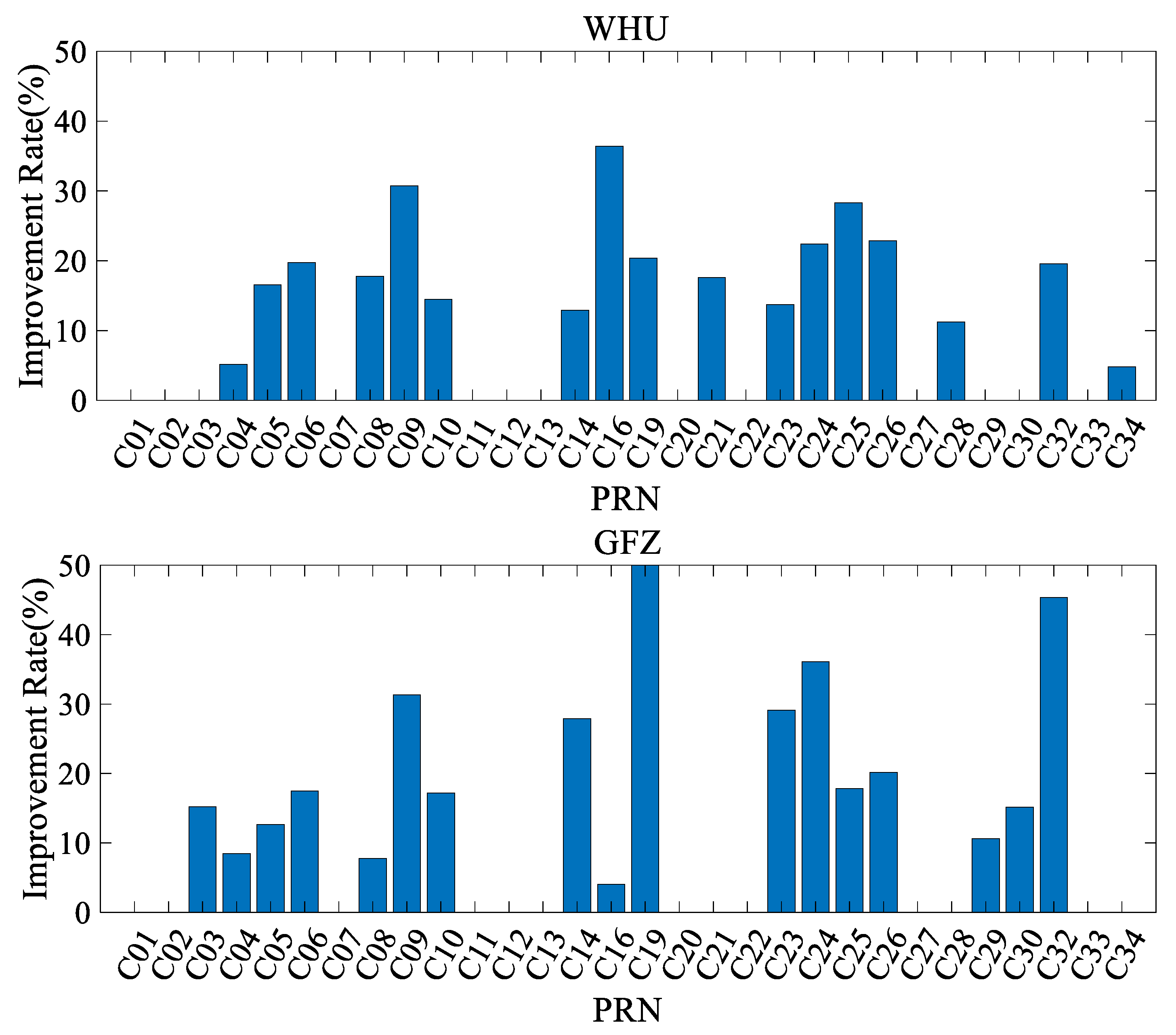
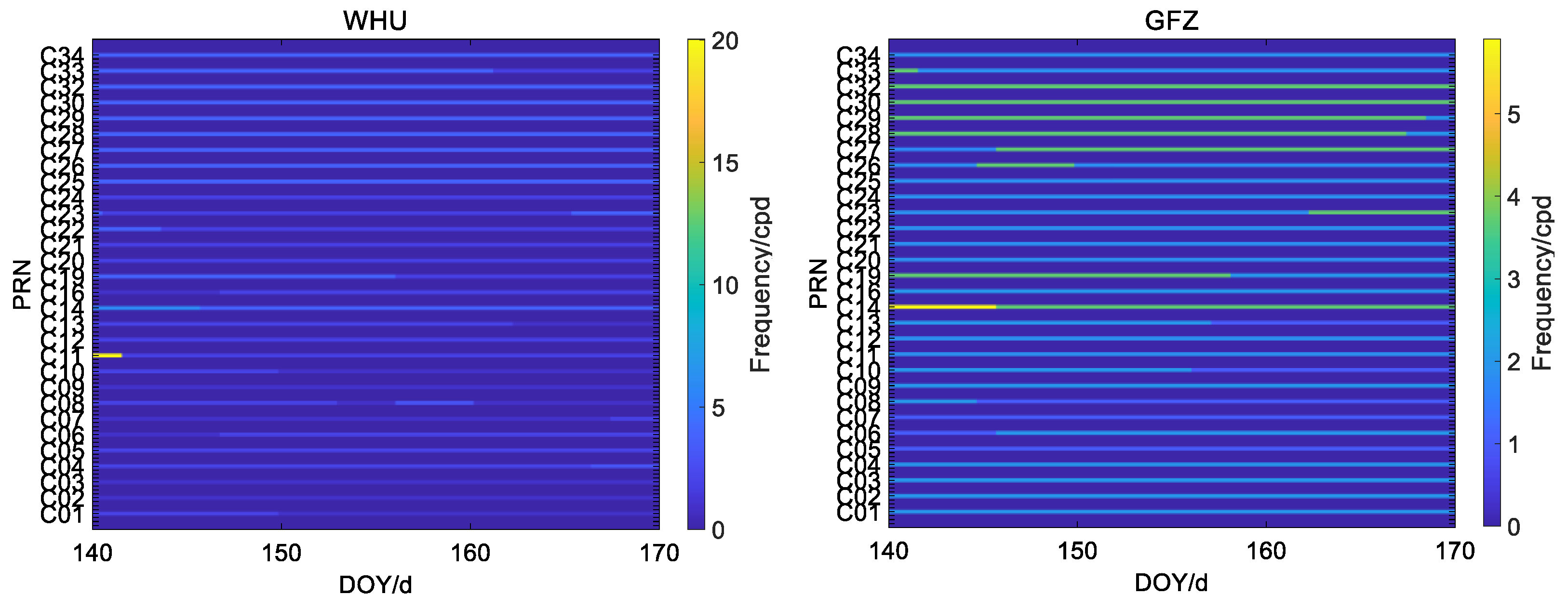
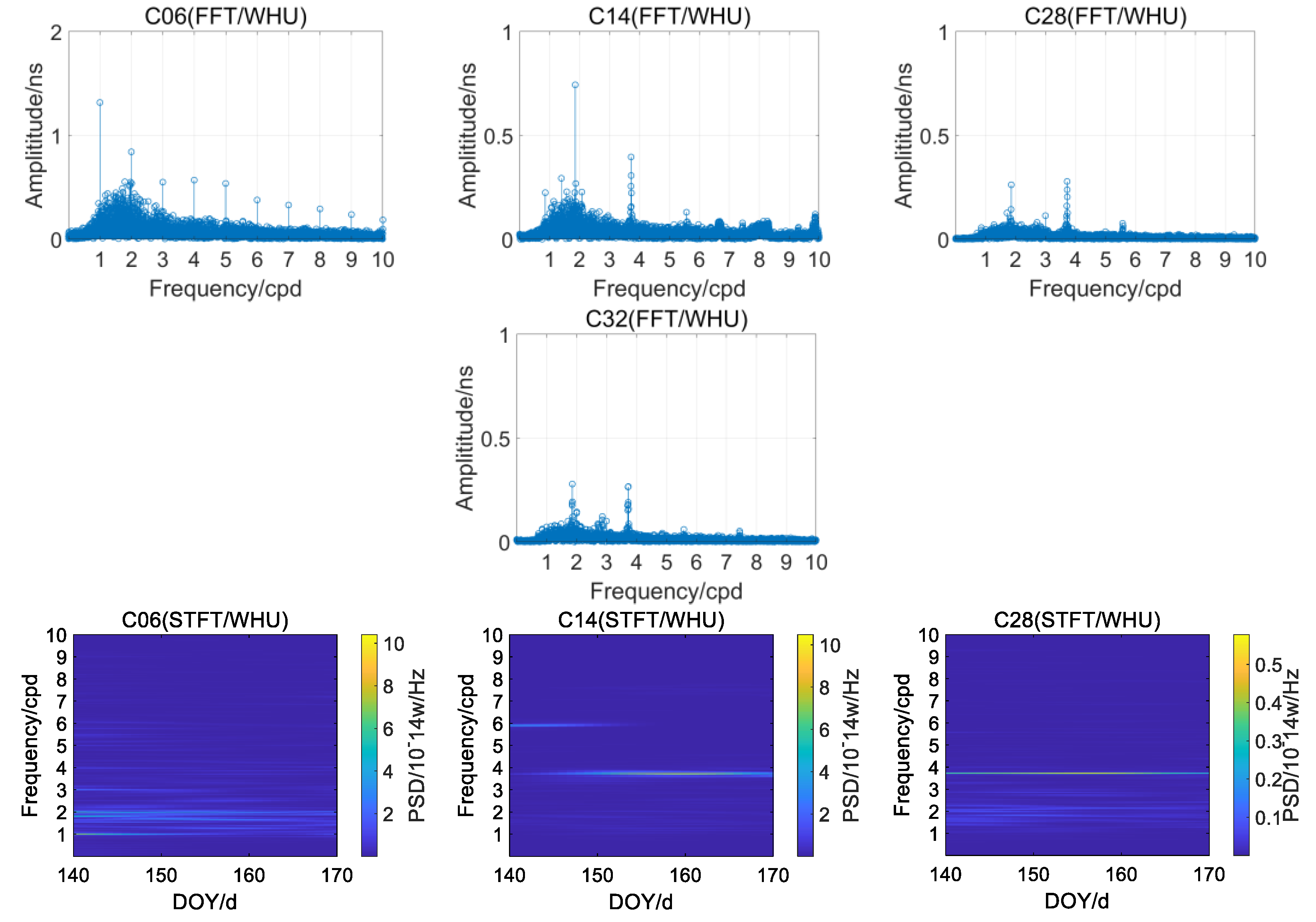

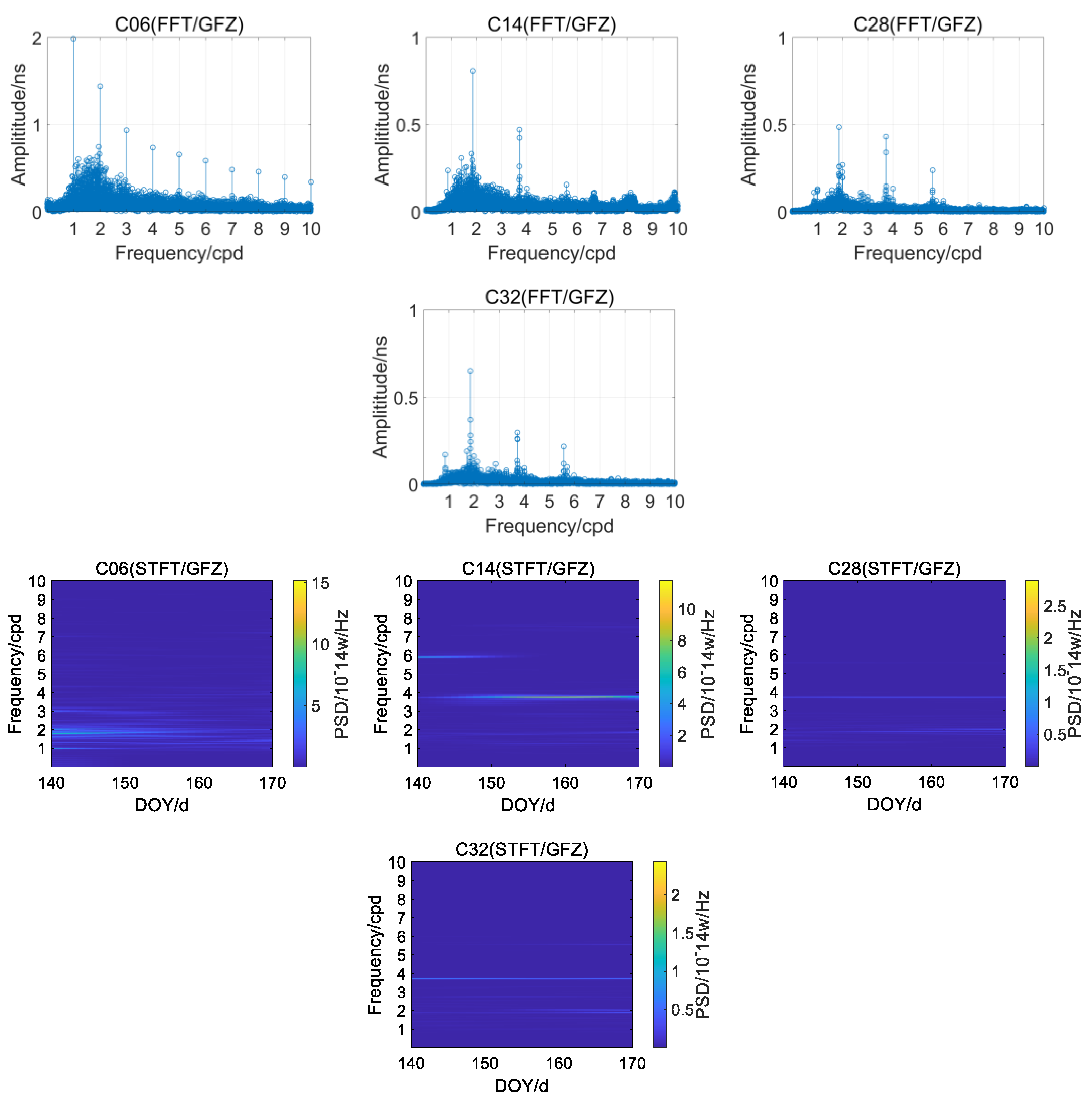

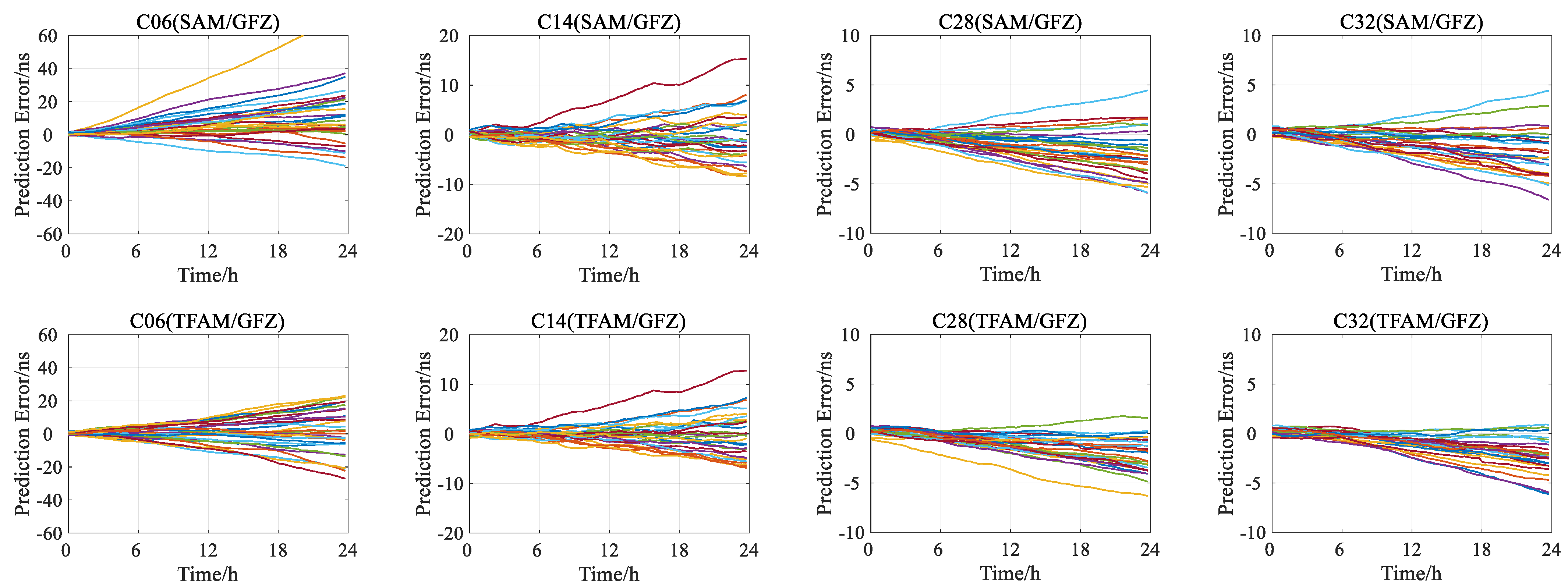
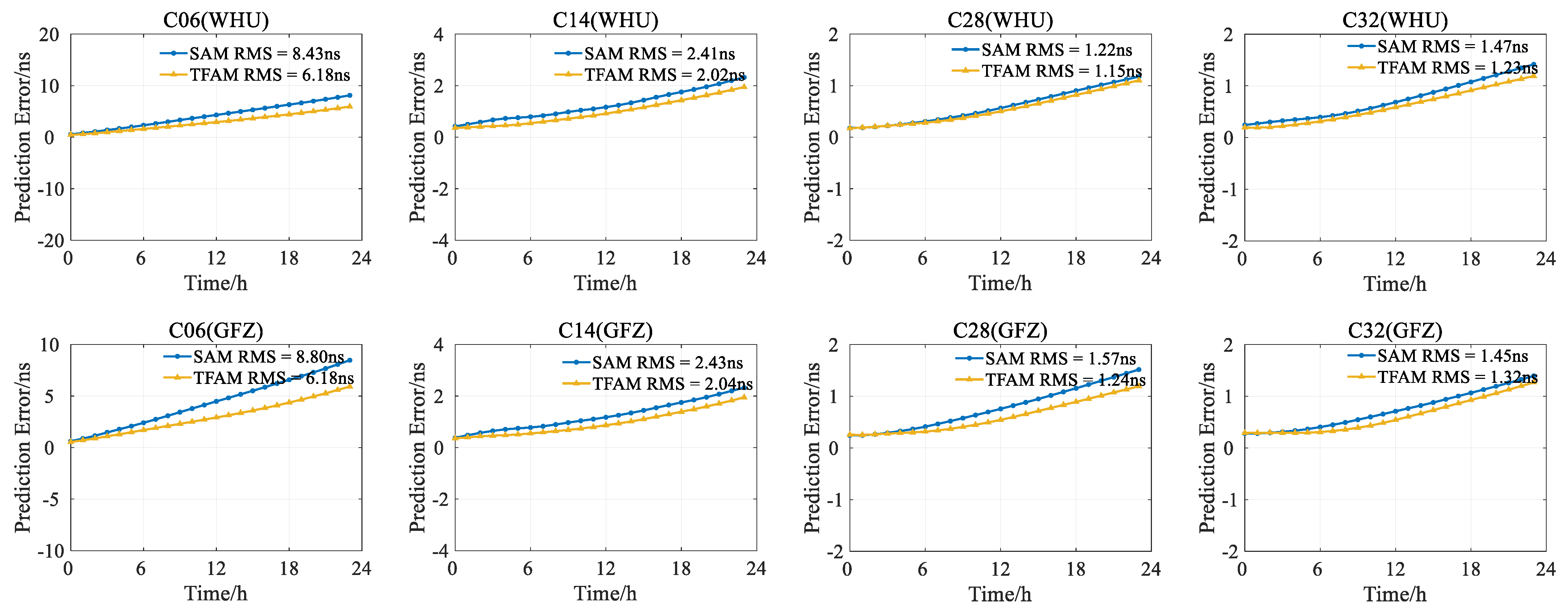
| Items | Models |
|---|---|
| Satellite attitude | BDS-2 (GEO: orbit-normal; IGSO/MEO: yaw-steering and orbit-normal); BDS-3: continuous yaw-steering |
| Satellite antenna PCO/PCV | PCO according to igs14.atx; ignoring PCV |
| Reference frame | IGb14 |
| Geopotential | 12 × 12 EGM2008 model [38] |
| N-body | Jet Propulsion Laboratory (JPL) DE405 |
| ocean tides | FES2004 [39] |
| Solid earth tides | IERS conventions 2010 [40] |
| pole tides | IERS conventions 2010 [40] |
| Relativity | IERS conventions 2010 [40] |
| Solar radiation | The 5-parameter ECOM1 model [35,41] |
| Antenna thrust | BDS-2 (GEO: none; IGSO: 185 W; MEO: 130 W [42]); BDS-3 (MEO: 130 W) |
| Earth Rotation Parameters | Static Earth’s Albedo model [43] |
| System | Satellite Type | Clock Type | Manuf | PRN |
|---|---|---|---|---|
| BDS-2 | GEO | Rb | CAST | C01, C02, C03, C04, C05 |
| IGSO | Rb | CAST | C06, C07, C08, C09, C10, C13, C16 | |
| MEO | Rb | CAST | C11, C12, C14 | |
| BDS-3 | MEO | Rb | CAST | C19, C20, C21, C22, C23, C24, C32, C33 |
| H | SECM | C25, C26, C27, C28, C29, C30, C34 |
| Clock Products | System | Satellite Type | 6 h | 12 h | 18 h | 24 h | ||||||||
|---|---|---|---|---|---|---|---|---|---|---|---|---|---|---|
| SAM | TFAM | IMP | SAM | TFAM | IMP | SAM | TFAM | IMP | SAM | TFAM | IMP | |||
| WHU | BDS-2 | GEO (CASC) | 1.52 | 1.46 | 3.9% | 2.52 | 2.52 | 0% | 3.73 | 3.68 | 1.3% | 5.16 | 5.09 | 1.4% |
| IGSO (CASC) | 1.75 | 1.50 | 14.3% | 3.52 | 3.00 | 14.7% | 5.31 | 4.63 | 12.8% | 6.97 | 6.36 | 8.8% | ||
| MEO (CASC) | 0.91 | 0.80 | 12.1% | 1.56 | 1.43 | 8.3% | 2.32 | 2.16 | 6.9% | 2.77 | 2.57 | 7.2% | ||
| BDS-3 | MEO (CASC) | 0.48 | 0.43 | 10.4% | 0.85 | 0.79 | 7.1% | 1.28 | 1.19 | 7.0% | 1.77 | 1.66 | 6.2% | |
| MEO (SECM) | 0.35 | 0.31 | 11.4% | 0.66 | 0.58 | 12.1% | 1.04 | 0.91 | 12.5% | 1.43 | 1.27 | 11.2% | ||
| Total | 1.00 | 0.90 | 10.0% | 1.82 | 1.66 | 8.8% | 2.74 | 2.51 | 8.4% | 3.62 | 3.39 | 6.4% | ||
| GFZ | BDS-2 | GEO (CASC) | 1.83 | 1.81 | 1.1% | 2.74 | 2.74 | 0% | 3.76 | 3.75 | 0.2% | 5.06 | 5.05 | 0.1% |
| IGSO (CASC) | 1.79 | 1.38 | 22.9% | 3.76 | 2.81 | 25.3% | 5.78 | 4.42 | 23.5% | 7.64 | 6.15 | 19.5% | ||
| MEO (CASC) | 0.86 | 0.76 | 11.6% | 1.50 | 1.34 | 10.7% | 2.23 | 2.04 | 8.5% | 2.75 | 2.54 | 7.6% | ||
| BDS-3 | MEO (CASC) | 0.45 | 0.41 | 8.9% | 0.87 | 0.76 | 12.6% | 1.33 | 1.18 | 11.2% | 1.83 | 1.67 | 8.7% | |
| MEO (SECM) | 0.41 | 0.36 | 12.2% | 0.80 | 0.66 | 17.5% | 1.23 | 1.06 | 13.8% | 1.70 | 1.49 | 12.3% | ||
| Total | 1.07 | 0. 94 | 12.1% | 1.94 | 1.66 | 14.4% | 2.87 | 2.49 | 13.2% | 3.8 | 3.38 | 11.1% | ||
Publisher’s Note: MDPI stays neutral with regard to jurisdictional claims in published maps and institutional affiliations. |
© 2021 by the authors. Licensee MDPI, Basel, Switzerland. This article is an open access article distributed under the terms and conditions of the Creative Commons Attribution (CC BY) license (https://creativecommons.org/licenses/by/4.0/).
Share and Cite
Zhao, L.; Li, N.; Li, H.; Wang, R.; Li, M. BDS Satellite Clock Prediction Considering Periodic Variations. Remote Sens. 2021, 13, 4058. https://doi.org/10.3390/rs13204058
Zhao L, Li N, Li H, Wang R, Li M. BDS Satellite Clock Prediction Considering Periodic Variations. Remote Sensing. 2021; 13(20):4058. https://doi.org/10.3390/rs13204058
Chicago/Turabian StyleZhao, Lin, Nan Li, Hui Li, Renlong Wang, and Menghao Li. 2021. "BDS Satellite Clock Prediction Considering Periodic Variations" Remote Sensing 13, no. 20: 4058. https://doi.org/10.3390/rs13204058
APA StyleZhao, L., Li, N., Li, H., Wang, R., & Li, M. (2021). BDS Satellite Clock Prediction Considering Periodic Variations. Remote Sensing, 13(20), 4058. https://doi.org/10.3390/rs13204058







